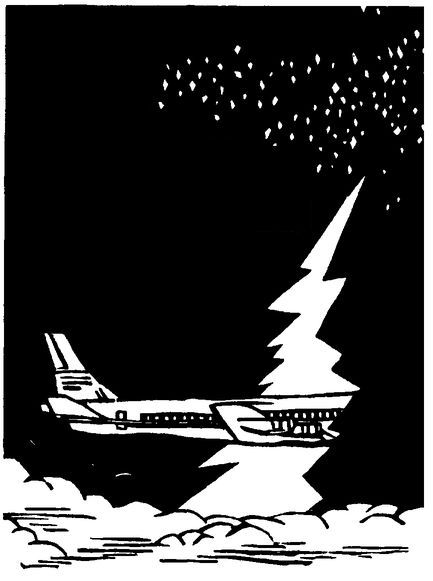
The Langoliers
THIS IS FOR JOE, ANOTHER WHITE-KNUCKLE
FLIER.
ONE PAST MIDNIGHT
A NOTE ON “THE LANGOLIERS”
Stories come at different times and places for
me-in the car, in the shower, while walking, even while standing
around at parties. On a couple of occasions, stories have come to
me in dreams. But it’s very rare for me to write one as soon as the
idea comes, and I don’t keep an “idea notebook.” Not writing ideas
down is an exercise in self-preservation. I get a lot of them, but
only a small percentage are any good, so I tuck them all into a
kind of mental file. The bad ones eventually self-destruct in
there, like the tape from Control at the beginning of every
Mission: Impossible episode. The good ones don’t do that.
Every now and then, when I open the file drawer to peek at what’s
left inside, this small handful of ideas looks up at me, each with
its own bright central image.
With “The Langoliers,” that image was of a woman
pressing her hand over a crack in the wall of a commercial
jetliner.
It did no good to tell myself I knew very little
about commercial aircraft; I did exactly that, but the image was
there every time I opened the file cabinet to dump in another idea,
nevertheless. It got so I could even smell that woman’s perfume (it
was L’Envoi), see her green eyes, and hear her rapid, frightened
breathing.
One night, while I was lying in bed, on the edge of
sleep, I realized this woman was a ghost.
I remember sitting up, swinging my feet out onto
the floor, and turning on the light. I sat that way for a little
while, not thinking about much of anything ... at least on top.
Underneath, however, the guy who really runs this job for me was
busy clearing his work-space and getting ready to start up all his
machines again. The next day, I—or he—began writing this story. It
took about a month, and it came the most easily of all the stories
in this book, layering itself sweetly and naturally as it went
along. Once in awhile both stories and babies arrive in the world
almost without labor pains, and this story was like that. Because
it had an apocalyptic feel similar to an earlier novella of mine
called “The Mist,” I headed each chapter in the same old-fashioned,
rococo way. I came out of this one feeling almost as good about it
as I did going in ... a rare occurrence.
I’m a lazy researcher, but I tried very hard to do
my home-work this time. Three pilots—Michael Russo, Frank Soares,
and Douglas Damon—helped me to get my facts straight and keep them
straight. They were real sports, once I promised not to break
anything.
Have I gotten everything right? I doubt it. Not
even the great Daniel Defoe did that; in Robinson Crusoe,
our hero strips naked, swims out to the ship he has recently
escaped ... and then fills up his pockets with items he will need
to stay alive on his desert island. And then there is the novel
(title and author will be mercifully omitted here) about the New
York subway system where the writer apparently mistook the
motormen’s cubicles for public toilets.
My standard caveat goes like this: for what
I got right, thank Messrs. Russo, Soares, and Damon. For what I got
wrong, blame me. Nor is the statement one of hollow politeness.
Factual mistakes usually result from a failure to ask the right
question and not from erroneous information. I have taken a
liberty or two with the airplane you will shortly be entering;
these liberties are small, and seemed necessary to the course of
the tale.
Well, that’s enough from me; step aboard.
Let’s fly the unfriendly skies.